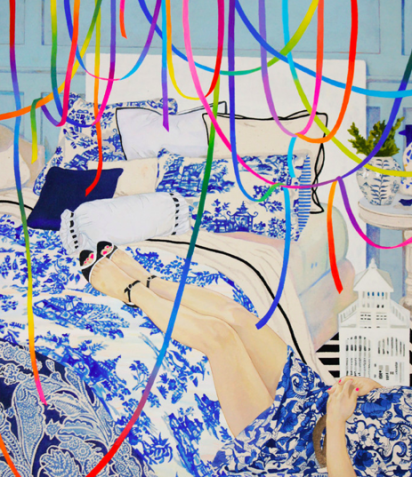
When I was 21 and had landed one of my first “real” jobs as an executive assistant to a music producer, I ran into a gal in the copy room who had just lost her dog, an 11-year-old pug named Winnie. She was heartbroken and numb and in need of a listening ear, so we sat together on our lunch break and looked at Winnie’s photos, exchanging stories about pets and grief and hardships. Between sips of tomato soup and bites of aged cheddar cheese, I said the only thing I could think of that would appropriately take away a small portion of her pain: “I know exactly how you feel.”
“Do you have any dogs?” she asked.
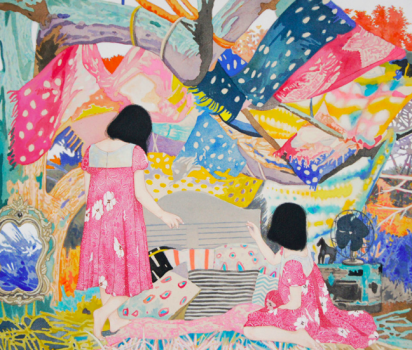
“A pug,” I answered, wishing for the words to boomerang back into my mouth as quickly as they’d shot out. It was a total lie, of course – I was a renter in a new apartment building across from the ocean and no, I didn’t have a dog. I didn’t even have a fish or a cat or gracious, a plant. I spent the rest of the conversation bonding with my new friend over bracheocephalics and shortened life spans and kibbles, sharing fashioned stories of my deaf pug Franklin (who was based loosely from tales I’d seen on movies or read in books) – awkwardly trying to change the subject quickly so she wouldn’t remember me as the girl with a pug lest we be actual friends and not lunch break friends.
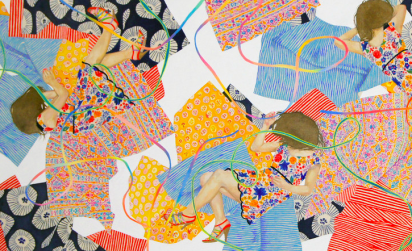
It was by far one of the weirder things I’ve ever done, and I still scratch my head at what could have possibly motivated me to orchestrate a faux life for a blip in the conversation. But I know this: I wanted her to feel understood. I wanted her to feel connected. I wanted her to belong.
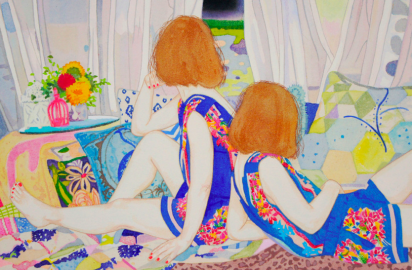
Of course, I wanted those same things for myself – I’d just moved to Los Angeles and was aching for a friend. It was a natural reaction to want to establish roots, branching out into tangled friendships that grow leaves and shadow us – jut a bit – from a greater society. But I went about it in the wrong way, choosing manufactured empathy over authentic vulnerability.
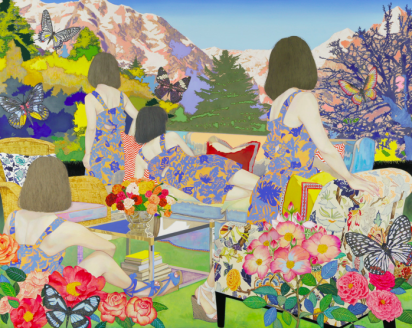
Artist Naomi Okubo explores many of these concepts in her achingly vulnerable portraits, all of which depict herself in many situations. “I think that people are not always honest with each other,” she writes. “In my adolescence, I had felt fear what others thought about me. Through this experience, I have showed plural self-portraits in my works. This idea is that I could escape the fears that came from the relationship with others if all people in the world were myself.”
Of course, exploring the relationship with her own image and expression is only part of her mission. The other? Everyone else.

“I am interested in the relationship between oneself and others or society and [the] contradiction that happens among the relationships. Food, clothing and housing are basic for human living. Today, a lot of material flood in advanced countries such as Japan and the U.S. Although people do not need to concern about how they can get food and where they can find out housing, they focus on what they should wear in and how others see their appearance everyday… the excess admiration and adoration for ideal image ties to social problem over the fashion’s range: mental disorder, cosmetic surgery, and shopping dependence and related issues such as prostitution.”
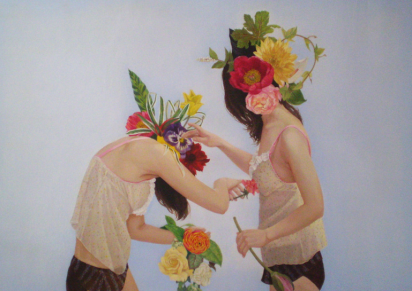
A particular portion of her words struck me this morning after a weekend of long pauses and heavy sighs, answering my own all-too-often-asked, “What should I wear?” conundrum. It’s a fabricated concern, of course, as the basic need for clothes is simply to protect. But there’s a deeper meaning behind the threads we choose to adorn ourselves with, and it’s one that Naomi explains well:
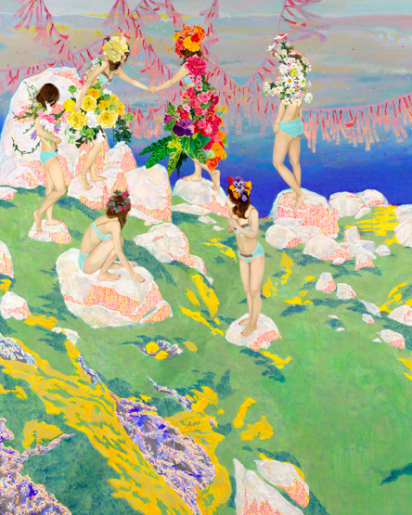
“I believe that fashion have two conflicted aspects: one side is to assert oneself: the other side is to harmonize oneself to the society. People try to harmonize with others and the society for smooth communication. However, the harmonization sometimes produces contradiction between the different images that they have and others do.”
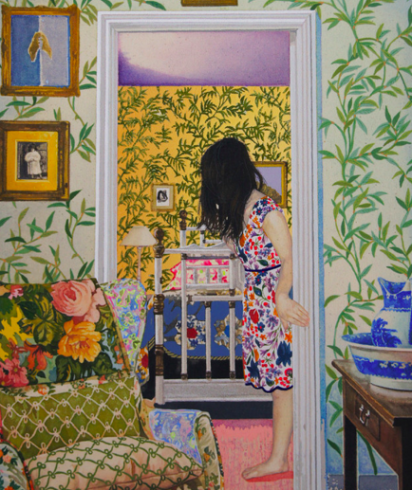
And therein lies the dissonance, the strained push and pull between harmonizing and asserting, performing and protecting. We dress to fit a mold, but what happens when there is no mold to fit? When the definition changes – when the decorations we choose to assert begin to blur into the very camouflage we hide behind?
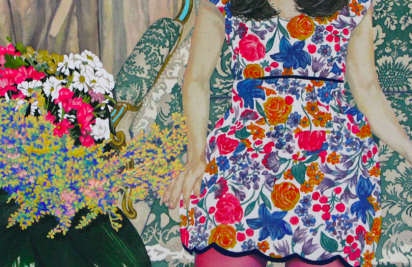
I’ve written about this before – many times, actually – and the concept seems to be shouting louder than ever as of late. Perhaps it’s nothing more than a personal conviction to rid my closet of unnecessary statements, the kind that I should be making with thoughts and ideas rather than leather and lace.
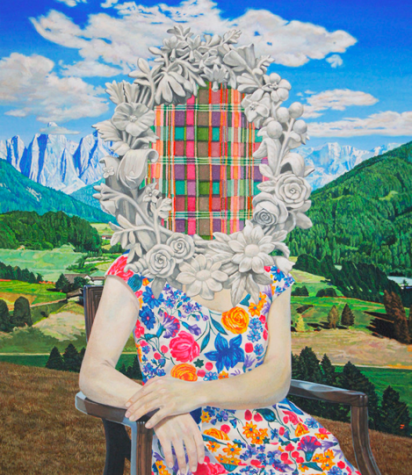
Or perhaps it’s something larger – a call to you. Perhaps I’m not alone, and you’re with me in these questions. Perhaps you’ve discovered your own version of balance – the beam that centers harmony and assertion – and are working to perfect your lean.
Perhaps you agree that these questions might point to a larger issue, one where we begin to manufacture empathy. The kind where we camouflage our stripes and tell tales of invisible pugs.*
Image Credit: Naomi Okubo
*Perhaps also, you are far more normal than I and have never once invented a fake pet. I’m predicting this to be likely.
p.s. The meaning of fashion.


I’ve never invented a fake pug but I’ve had my versions of that in my own struggle between harmony and assertion, my desire to “fit in” and be part of the mainstream while also knowing that it just isn’t “me”.
“manufactured empathy over authentic vulnerability” <—-THIS you must copyright or print or carve in stone. Yes to this. It's like a shortcut to connection that both sides engage in. We fake the commonalities and we also WANT the other person to fake them too so that we can connect on a superficial level.
Well, maybe not superficial – it's not that – it's more that shortcut to connection again. Rather than wait and risk and be vulnerable by being "us", we adopt a persona to feel a bit safer.
Where do we get this message "being your quirky self = being along while going along with the mainstream = connection"?
EXACTLY! It’s such an odd message that we’re creating, isn’t it? And I agree – it’s not an attempt to be superficial, but you’re right – a total shortcut. Here’s to more quirk, I suppose?
Your question is at the center of my discontent and unease with writing a home blog. I love to look to others for inspiration and ideas. As when I was writing poetry, others’ work is necessary to prime the pump for my own. But it so quickly and easily becomes about something other than creating a setting that supports the life we want to live. It is hard to be part of that community without feeling that I’m contributing to things I don’t like. And it’s hard to find acceptance in that community when I share my critical stance toward it. No easy answers, I think, whether it’s fashion design or interior.
I can 100% COMPLETELY relate, lady. :)
I’ve never made up a pet but I have done way crazier things, believe me. Mostly just because, like you say, of that need to fit and be what (I imagine) someone is looking for. It’s only now that I’m in my 30s that I’m actually finding the strength of character to bust out my own self and try not to care if it seems odd or out of place to anyone else. I wish it were easier for all of us.
30’s are the best, aren’t they, Jenny?
Back in the day I invented a fake dog as well and, just like you, wondered why in the world I said he existed as soon as the words were out of my mouth! I came up with a back story based loosely on the dog my family took care of for a family friend when I was in college! I’m so relieved to hear I’m not the only one to have done this in order to bond with a person and make them feel better about their situation!
Ha, is that not the weirdest thing ever? We’re crazy.
Thank you. Beautiful article. I needed this today. Thank you.
I love this post so much. That is all :)
Thank you. :)
This design is wicked! You obviously know how to keep a reader
amused. Between your wit and your videos, I was almost moved to
start my own blog (well, almost…HaHa!) Wonderful job.
I really loved what you had to say, and more than that, how you presented it.
Too cool!